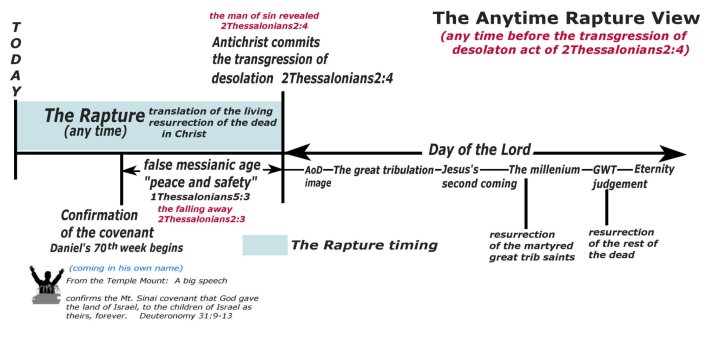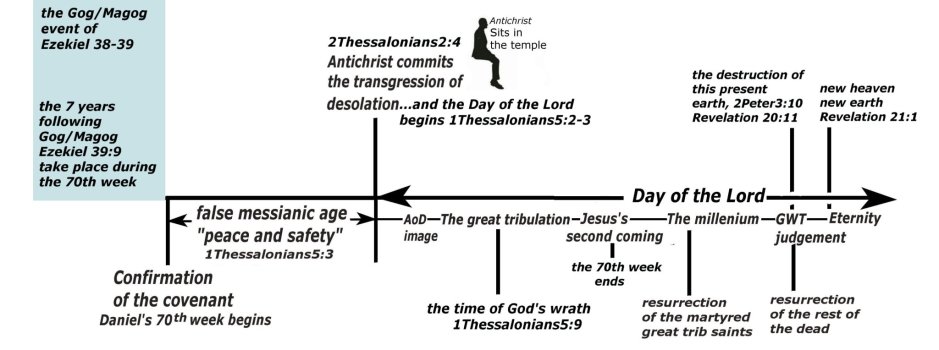2 Peter 3:10 is talking about this present earth being completely destroyed. It will happen right before the Great White Throne Judgment in Revelation 20. Here is the verse...
Revelation 20:11 And I saw a great white throne, and him that sat on it, from whose face
the earth and the heaven fled away; and there was found no place for them.
Differently, the sudden destruction in 1Thessalonians5:2-3 is not referring to the entire planet being destroyed, but the destruction to take place during time of God's wrath (1Thessalonians5:9).
Take a look at this time line chart - all of the verses are referenced on the chart.
View attachment 49841
He has already told you many times that he is not going to engage with your silly charts. I don't know whether anyone looks at them, but they are a waste of time. It is now time to engage with Scripture instead of running from it.
How is it not global? Where does it say that? You make it up as you go. You might as well invent Bible that allows Pretrib.
A careful study of the Greek words
ouranos and
gē mentioned in 2 Peter 3, which some Premillennialists are forced to redefine, shows your interpretation to be in error. 59 times in the New Testament “heaven” and “earth” are coupled together in the same passage describing exactly what the outside of the box says – what most ordinary people would understand as “heaven” and “earth.” Interestingly, in every case where the two Greek words
ouranos and
gē are employed to describe the heavenly realm and the globe of the earth. Philippians 2:10 is the only slight variation, although it is only a technical difference, where a literal reading of the text should read ‘earthly’ (
epigeios) and ‘heavenly’ (
epouranios). However, both significantly were derived from the same two repeated Greek words used elsewhere to describe “heaven” and “earth” –
ouranos and
gē. What is more, of the 6 references to “heavens” (plural) and “earth” all use these two same Greek words.
2 Peter 3:10-13 couldn't be clearer:
“the day of the Lord will come as a thief in the night; in the which the heavens ouranos shall pass away with a great noise, and the elements [Gr. stoicheion] shall melt with fervent heat, the earth [Gr. gē] also and the works that are therein shall be burned up. Seeing then that all these things shall be dissolved, what manner of persons ought ye to be in all holy conversation and godliness, Looking for and hasting unto the coming of the day of God, wherein the heavens [Gr. ouranos] being on fire shall be dissolved, and the elements [Gr. stoicheion] shall melt with fervent heat? Nevertheless we, according to his promise, look for new heavens [Gr. ouranos] and a new earth [Gr. gē], wherein dwelleth righteousness.”
It is not just that Peter is delineating the removal of the old heavens and earth at Christ’s return; he significantly describes the replacement of the old corrupt arrangement with a new heavens and earth at this climactic event. No one would surely feel the need to localize this depiction unless they were trying to sustain a doctrine that contradicts this passage.
Surely no one would try to limit the subject and scope of the new heavens and earth in view; so why would they do it to the old heaven and earth? Why would the Lord when He comes in all His final glory introduce a replacement earth that is little (or no) different than that which He just burnt up? This simply doesn’t make sense.
If the remedy for the corruption of the old heavens and earth is the introduction of a brand-new perfect heavens and earth then we are looking at an all-consummating reference to the destruction of the current globe and the existing heavens. The old arrangement that is marked by sin and rebellion is indeed destroyed by fire (as Peter said) and changed to a new glorified perfect arrangement “wherein dwelleth righteousness.” The limitations of this present earthly life are left behind forever. This allows no room for the continuation of unrighteousness or corruption as Premils insists. Such is totally eliminated through the conflagration.
He certainly isn't referring to part of the “new earth,” so why would he be referring to only part of the earth as it is now? That doesn't line up. He is contrasting the heavens and earth as it is now to the new heavens and new earth, just as John does in Revelation 21:1. This totally correlates with the detailed description of the conflagration and the introduction of the new perfect arrangement in Revelation 21. John describes the exact same event in Revelation 21:1-5 as Peter did in 2 Peter 3.
This parallel reinforces the belief that the second coming of the Lord Jesus Christ occurs at the end of Revelation 20, not at the start. Interestingly he uses the same words for heaven and earth as Peter, but he adds further elucidation on the bliss of the new earth. What Peter sums up in one statement “we, according to his promise, look for new heavens and a new earth, wherein dwelleth righteousness,” John gives in greater detail.
Revelation 21 proves that the new arrangement is incorrupt:
“And I saw a new heaven [Gr. ouranos] and a new earth [Gr. gē]: for the first heaven [Gr. ouranos] and the first earth [Gr. gē] were passed away; and there was no more sea … And God shall wipe away all tears from their eyes; and there shall be no more death, neither sorrow, nor crying, neither shall there be any more pain: for the former things are passed away. And he that sat upon the throne said, Behold, I make all things new.”
Any limitation placed on the wording and detail of the destruction described in 2 Peter 3, in order to prolong the current earth, must also equally be applied to Revelation 21 – if Premils are going to be consistent. Both passages describe the same all-consummating event and show the same glorious restoration. Of course, all the schools of thought are in total agreement with the finality embodied within Revelation 21 and the perfection the new ushers in. 2 Peter 3 should then be viewed in exactly the same as it refers to the same event. In each we see the passing away of the old and the introduction of the new. Both readings beautifully correlate and show that the new earth is devoid of corruption or the Fall and characterized by righteousness and perfection.
Placing 2 Peter 3 and Revelation 21 side-by-side demonstrates that the first heaven and first earth will pass away as a result of being burned up by fire. That is very clear. But what will result in the passing away of the heavens and earth with fire? The introduction of the new heavens and new earth. This fits like a glove whereas the Premillennial understanding of 2 Peter 3 makes it completely unrelated to Rev 21:1. If Premillennialists were consistent in their hermeneutics they would insist that "the first earth" mentioned in Revelation 21 is also only speaking of a part of the earth rather than the entire earth. But of course they don’t. It would obliterate their reasoning.
Premillennials skate around the fact that this future fiery event is compared directly to the flood. How much of the earth was covered by the waters of the deluge? All of it. 2 Peter 3:7 confirms,
“the heavens [Gr. ouranos] and the earth [Gr. gē], which are now, by the same word are kept in store, reserved unto fire against the day of judgment and perdition of ungodly men.” That means whatever was affected by the waters of the flood, by the same word, will be affected by the fire to come. There is simply no basis for thinking that any part of the earth will spared from this fiery judgment.
It is right and proper to view this word
gē as referring to the whole earth. The old earth is destroyed and replaced by a new glorified earth.



